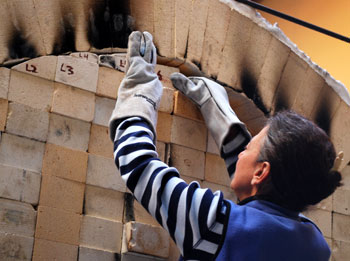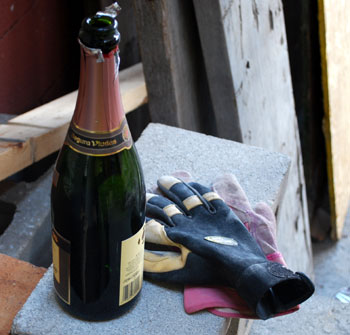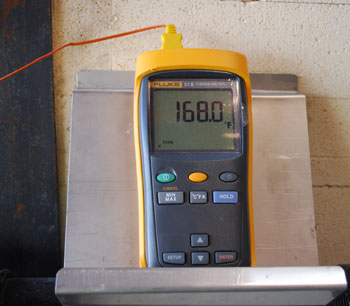Good News: You’re Fired!!

Kay Yourist opens the kiln after its first firing. It's a brick-by-brick process. The top row is labeling for ease of re-assembly.
By the time The Chronicle arrived at Yourist Gallery on Broadway Street last Wednesday, the temperature had cooled from its maximum of 2300F° to around 170F°. The owner of the gallery, Kay Yourist, had donned giant leather gloves to open the door to her new kiln after its first complete firing the previous night.
The door to the kiln is actually a wall of un-mortared bricks that gets opened and closed by stacking and unstacking the wall brick by brick. The top few rows of bricks, which were sourced through Schad Boiler Setting Company in Detroit, are custom shaped to match the arch of the kiln’s roof, and labeled to prevent the door-closing task from evolving into a puzzle-solving exercise.
Even though we were there to see the opening, we got a chance to see a bit of the closing process, too – Yourist had actually begun the opening process before we arrived. But she indulged us by first re-stacking the bricks into a solid wall, so we’d have a clearer idea of how it worked.
Unstacking the bricks was slow going at first, but once Yourist had un-wedged the top row, the pace picked up. It wasn’t long before the top front layer of pottery pieces became visible. The kiln has three tiers and a front and a back, so the volume of art work we saw was about a sixth of the kiln’s total capacity.

This collection of pieces was the first to become visible during the unstacking process. It's one of six sections in the three-tiered, two-sided kiln.
It was a story we’d been tracking since talking to Yourist late last year. She’d initially hoped to complete the first firing before the end of 2008, but a mis-communication on the permitting and inspection side of things led to the delay. Hers is a commercial installation, and the initial design had satisfied requirements for a household installation. The key difference was the requirement that the chimney be made of brick as opposed to a steel pipe, and to construct a brick chimney – with mortar, unlike the kiln door – required a moderation in the weather, which finally came a few weeks ago.
On the day before tax day, Yourist emailed us to say that they’d finally passed the mechanical inspection.
A sign in the gallery soliciting contributions to help fund the new kiln indicates there are 1,000 bricks costing about $3 apiece. Yourist said that the dollar amounts of the contributions over the last year and a half were not huge but around 100 people had participated. So it was a way for people to contribute however much they were able, she explained. She said it was particularly gratifying when a child would visit the studio, see the sign, and want to become a part of the project.
Beyond the $3 cost per brick, the project cost included the construction, the gas heating element, plus the remodeling of the studio to provide access to the outdoor kiln. The total cost of the project came to around $30,000. The design for the work was done by rizzolobrown + novak, with construction completed by Monal, Inc.
Why make the $30,000 capital investment? Yourist said, “I want to give our students the best they can have. If you give people the best you can give, then people will notice.” She explained that part of the project will entail teaching the students at the pottery studio how to use the new kiln. Once the initial learning curve is overcome, she imagined that the big kiln will be fired about once a week.
How much natural gas does it take to fire up the kiln? Yourist said they’ll be able to measure that exactly, because there’s a dedicated gas line just for the kiln.
The contrast between the electric kilns that Yourist has been using and the new gas kiln is the kind of atmosphere that exists inside the kiln during firing. In an electric kiln, you’re just adding heat, so there’s no reduction in oxygen content. With the gas kiln, there’s less oxygen, due to combustion, and the additional carbon adds more interest to the glazes on the pots, Yourist explained. It means that predicting results with the gas kiln is a little harder.
As for the studio’s three electric kilns – they’re not getting fired, erm, or they’re still going to get fired, too. That is, Yourist is keeping the electric kilns.








Congratulations on the new kiln. I looks like a good firing from the picture in the paper ( I saw it on the website). I am sure you will enjoy it and that it will add depth and richness to the ceramic scene in Ann Arbor.